Apple unveils iPhone 13, Apple Watch series 7, new iPad and iPad mini
Four iPhone 13 models, a new iPad, iPad mini and Apple Watch have been unveiled at a launch event in California.
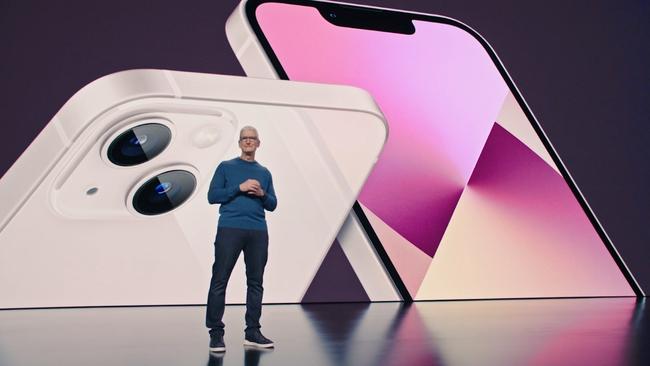
Four iPhone 13 models, a new iPad, iPad mini and Apple Watch have been unveiled at a launch event streamed from California
For Apple devotees, there was good news. Starting prices of the iPhone 13 models on Apple Australia’s website are the same as for iPhone 12 models promoted last year.
You pay from $1199 for iPad mini, $1349 for iPhone 13, $1699 for iPhone 13 Pro, and $1849 for iPhone 13 Pro Max. All models start with 128GB of storage, with 256 and 512GB options. The Pro and Pro Max also offer one Terabyte of storage.
Speculation was rife that Apple would hike the prices of iPhone 13 models due to global chip shortages experienced in the electronics industry, but that was not the case.
Existing iPhone SE, iPhone 11 and iPhone 12 and iPhone 12 minis will remain on sale at reduced prices. Note that the iPhone 12 Pro and iPhone 12 Pro Max are not being carried forward.
You can pre-order from 10pm this Friday September 17 with availability in stores beginning September 24.
If you are not buying a new iPhone, there is good news anyway. Apple says it will release iOS15 from Monday September 20, which will bring a swag of software updates to existing iPhones.
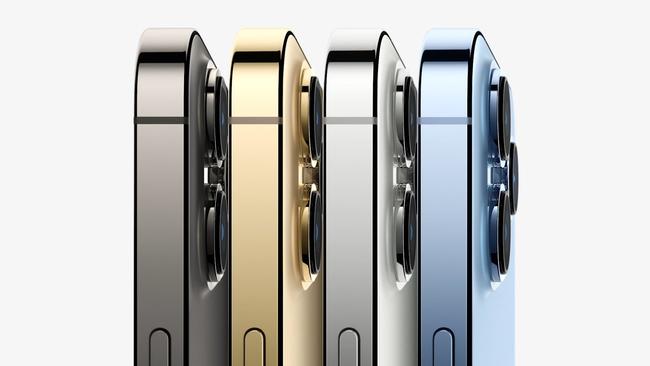
Overall the 2021 handsets are a step up from 2020 models with faster processors and graphics capability, improved camera systems, longer battery life, and faster image processing with Apple’s on handset neural/machine learning engine capable of a mind boggling 15.8 trillion operations per second, a capability that means better on-device processing of language and photographs.
There was no mention of using iPhone 13 to send satellite messages for emergency calls as predicted by some US publications, nor astrophotography, nor new AirPods. Astrophotography on iPhone always sounded suspicious IMO.
All phones do offer 5G coverage, but as in 2020, they do not support super fast millimetre wave (mmWave) 5G in Australia. I could understand this in 2020, when Australia’s mmwave landscape was not functioning, but the spectrum auctions have taken place and mmwave will begin to operate as we come out of lockdown. It should have been available on what are four-figure dollar iPhones this year.
iPhone 13 mmwave support remains available only in the US at this time.
The prediction of iPhone 13 shooting blurred backgrounds in video (the Bokeh effect) turned out to be partly correct but went further than speculated. Apple announced a new video ‘cinematic mode’ that brings the main subject in an image in focus and automatically blurs the areas around it.
Using machine learning, the iPhone 13 can perform ‘rack focusing’ in real-time, moving the in-focus area of video from one person to another by predicting who is moving into the shot. You can override the automatic setting and change the focus during and after capture. Apple presented a video sequence shot with this feature and the capability of machine learning to perform this is impressive. Shooting is in Dolby Vision, HDR. It was, in my view, the star feature of the launch.
Machine learning also will aid the on-device speech recognition by Siri that Apple is rolling out with iOS15. Apple says audio requests will no longer leave your iPhone, at least by default.
Sadly, as predicted, there is no touch ID finger print recognition. While it is a thing of the past on iPhones, it would have been useful to have fingerprint recognition this year given we are resigned to wearing face masks and I’m forever entering my PIN when opening an iPhone when able to be outside. It would have been pandemic friendly and, of all features that Apple could introduce, would have made a difference to millions.
The unveiling came as existing Apple users are being urged to update their iPhones and iPads to iOS14.8 and iPadOS 14.8 respectively. Apple has warned that “a maliciously crafted PDF may lead to arbitrary code execution”.
“Apple is aware of a report that this issue may have been actively exploited,” the company says.
iPhone 13 and iPhone 13 mini
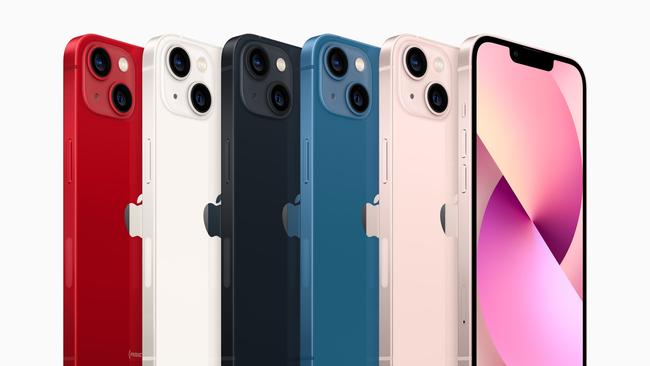
These two models have 6.4-inch and 5.12-inch displays respectively and this year Apple says they are tough with a “ceramic shield” on the front and IP68 water and dust resistance. That’s just as well because cracked iPhone screens cost a motser to replace. The handsets come in pink, blue, midnight (black), starlight (white) and product red.
There are lots of incremental improvements. Apple says the black notch area on the front which houses the camera system is 20 per cent smaller than last year, the display is 28 per cent brighter at 800 nits, and up to 1200 nits when viewing content such as HDR videos. The screen supports Dolby Vision, HDR10, and HLG.
This year’s iPhones are powered by Apple’s A15 bionic chip with a 6-core CPU, 4-core GPU and 15 billion transistors aboard, along with the capability of 15.8 trillion operations per second. This capability means better text-to-speech with Siri, on device processing of directions in maps, more subtle lighting effects in games and faster graphics. There will be more efficient camera image processing and computational photography, introduced with iPhone 12.
You will be able to identify mountain peaks, and take a photo of a plant or animal with the camera and identify it (at least in the US). Apple says a machine learning model has been trained with 20 million photos of plants and animals.
The camera comprises two lenses. A bigger 1.7 micron sensor offers better lower light photography, and the optical image stabilisation offered with higher iPhone 12 models comes to iPhone 13 base models. You get a 12MP ultra wide lens camera.
Apple says the Mini will deliver 1.5 hours more battery life, the iPhone 13 some 2.5 hours more.
These are evolutionary changes rather than whiz-bang new concepts, but you get more bang for similar buck compared to iPhone 12 last year.
iPhone 13 Pro and iPhone 13 Pro Max
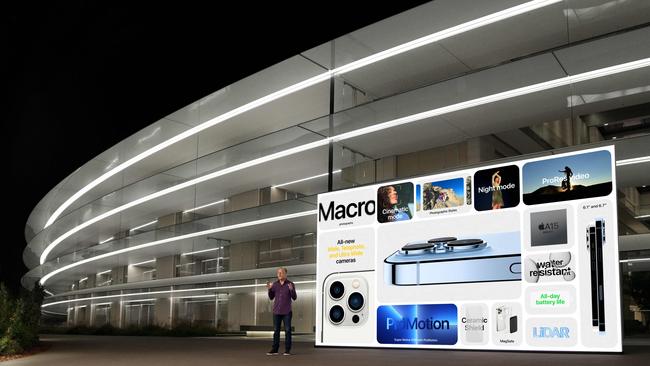
These 6.1-inch and 6/7-inch handsets are mainly about faster performance and advanced smartphone photography. The display features an adaptive refresh rate of up to 120Hz, which means the phone can speed up the frame rate for fast action, and slow it down to save battery if you are doing more mundane tasks such as surfing the web.
You get telephoto, wide and ultra wide lenses on the back as before, macro photography on the ultra wide lens (photos and video) and better lower light performance on the wide lens.
Apart from cinematic mode, the pick of new features is “photographic styles’ where you can personalise the look of a series of images. Both models support night mode photography on all lenses. Movies can be shot using the cinematic video codec ProRes2, and you can capture, edit and share video in Dolby Vision or ProRes.
Battery life again has been improved in 2021: you get 1.5 hours longer for the iPhone 13 Pro and 2.5 hours longer for iPhone 13 Pro Max, says Apple, when compared to the same models last year.
Apple Watch series 7
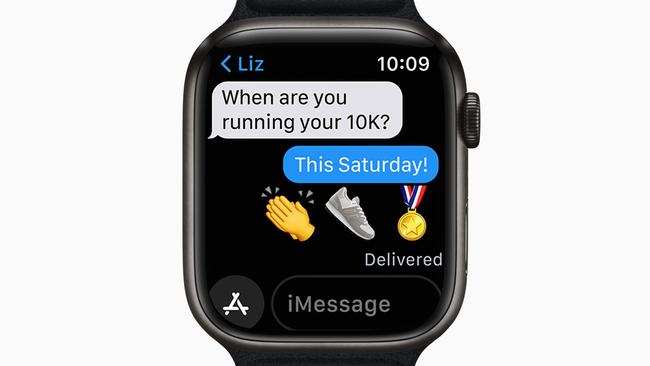
Series 7 is an improvement on series 6, with a slightly more rounded look. The watch has 20 per cent more screen area and a smaller frame around the edges.Overall its thinner, with a 1.7mm thick display. Apple says the display is 70 per cent brighter indoors, action buttons are bigger making them easier to press, and the screen fits more text when you read messages.
Apple has been audacious to include a full QWERTY keyboard on the watch face. You tap or slide your finger to write messages and it uses machine learning to predict text and to speed up your messaging. It’s a big ask to attempt QWERTY input and I will be very interested to try this when we get our test unit.
Apple says the series 7 watch is more durable, with crack resistance and IP6X and WR50 dust and water resistance respectively.
It offers 18 hours of battery life and is faster to charge. Apple says charging time is 33 per cent faster thanks to a new faster charging USB-C cable. It takes 45 minutes to go from zero to 80 per cent charged. It will be available in five aluminium colours, as well as in silver, graphite, gold stainless steel and titanium.
Apple didn’t announce pricing and availability. It just said the line-up will be available later this year. When it is available, you will be still able to buy Apple Watch Series 3 and Apple Watch Series 6.
There was some news for cyclists. Apple watch will be able to detect if you are riding a bike and suggest you start a cycling workout. You’ll get more accurate stats too if you are riding an eBike. That sound like less cheating.
iPad 9th generation
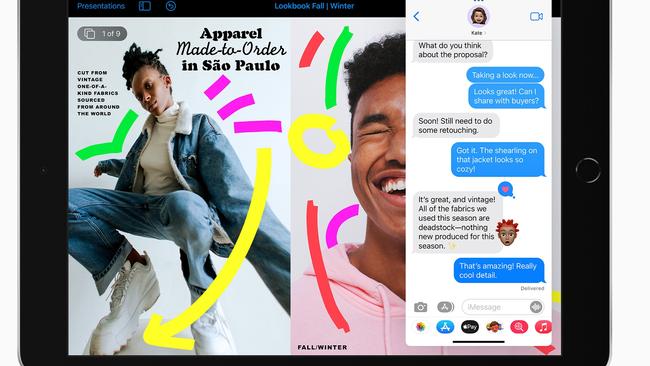
The regular iPad now has an A13 bionic chip offering faster performance and enhanced machine learning, which will improve the speed of live texting in the coming iPadOS 15. Apple claims a 20 per cent bump in graphics performance which will improve the iPad’s gaming credentials. The 12MP ultra wide camera at front offers better low light photography, assisted focus while the front snapper takes better selfies.
You get an 8MP wide camera on the back, and 12MP ultra wide camera at front.
This front facing camera supports “centre stage”, a feature taken from the iPad Pro which automatically pans to ensure a person is in the frame during video calls. Centre stage supports third party video calling apps such as Zoom and Webex as well as Apple FaceTime. Centre stage can also be used to create selfie videos for social media.
This iPad supports Apple Pencil generation 1 and third party keyboards, is available as a WiFi model only in Australia and costs from $499 for a basic model with 64GB of storage. Cheaper educational pricing is available.
iPad mini
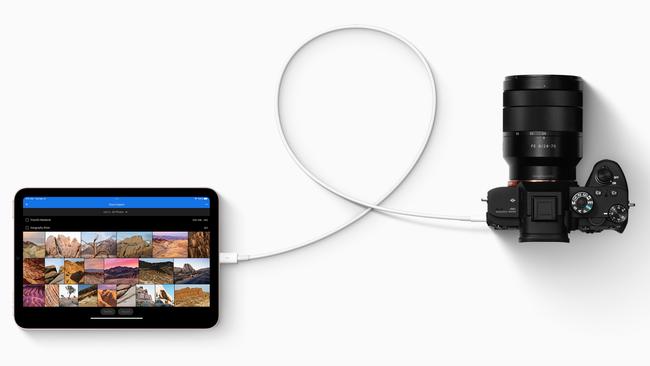
Apple’s smallest iPad, the iPad mini, has undergone a major transformation with a fast A15 bionic chip designed to make it a speed machine.
Apple says it is more powerful than the previous mini, which in turn was a big step up from how the mini was originally.
Significantly, Apple has transitioned from using a lightning port connector to USB-C. That opens up the mini to new functionality, such as connecting USB-C devices like cameras, scanners, and even ultrasound and micro-optic devices. You can attach iPad mini to a 4K monitor.
This model has an 8.3-inch liquid retina display, narrow borders and rounded corners, comes with touch ID, and promises a 40 per cent jump in CPU performance and 80 per cent jump in GPU performance with the A15. Apple says it can translate text in real time thanks to the faster neural engine.
The iPad mini retains touch ID but places it on a button at the top right.
The mini has a 12MP camera on the back with a larger f/1.8 aperture for low light snaps, and it can record 4K video. The front has a 12MP ultra wide camera with a 122 degree field of view.
There’s a new speaker system with landscape stereo and the device supports Apple Pencil generation 2.
iPad mini costs from $749, and is available as both WiFi and 5G cellular models. It comes in purple, pink, star white and space grey.

To join the conversation, please log in. Don't have an account? Register
Join the conversation, you are commenting as Logout